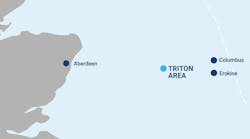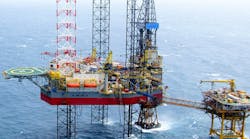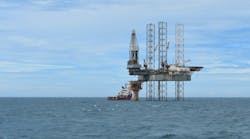Aussie-Indonesian ZOC delivers another discovery
The success story in the Timor Sea Zone of Cooperation continues, with the latest well completed, BHP's Hingkip-1 m ZOCA 91-12, being suspended as a future possible gas producer on 26 June after reaching TD at 3,185 meters. The well is located on a prominent structural trend about five km north of the Bayu-Undan gas/condensate field. Preliminary results show a higher liquids content in the Hingkip gas compared to Bayu-Undan, suggesting the accumulations may not be in communication.Mobil's Kelp Deep 1, spudded on 19 April and located in ZOCA 95-18, has reached TD at approximately 4600 meters and testing was being contemplated. The well has been declared a tight hole by the operator.
Brunei's Block CO proves to be dryhole
The testing program on Fletcher Challenge Energy Borneo's Perdana Deep-1, located in Block CO in the Baram Delta Basin, has proved unsuccessful. The well was spudded on 9 April by Stena Drilling's Stena Clyde semi submersible. Gas shows had been reported from the Miocene 100 sequence but the primary objective Miocene 500 stacked turbidite sequence proved to be devoid of hydrocarbons.China adds new fields in both Bohai and Beibu
CONHW well, Ledong (LD) 8-1-5, in the Yinggehai Basin, has been plugged and abandoned as a gas well in mid June after being drilled to a TD of 1,320 meters and testing gas from two sandstone zones. DST-1 flowed 13.7 million cf/d (54% C02) while DST-2 yielded 15.1 million cf/d (4% CO2).Meanwhile in the Bohai Gulf, Kerr McGee's Caofedian (CFD) 2-1-3 delineation well in PSCA 04/36 was temporarily abandoned at the end of June. The well had reached TD at 3,960 meters and was drilled using the Bohai-4 jackup. This was a further appraisal of 1996's CFD 2-1-1 discovery which flowed 5,957 b/d oil and follows CFD 2-1-1, which tested 4,100 b/d oil during early May 1997.
Texaco's wildcat in PSCA 11/19 in the Bohai Gulf, Bozhong (BZ) 27-5-1, which was spudded on 5 March by the Bohai-12 jackup, was plugged and abandoned dry on 26 May at a TD of 4,136 meters. Three DSTs were run but were unsuccessful.
New Indonesian gas discovery by Unocal in East Kalimantan
Unocal successfully completed Merah Besar-3 m its East Kalimantan PSC as an oil and gas discovery on 18 June. The well, located in the prolific Kutei Basin, was designed to test the hydrocarbon potential of Upper Miocene deltaic sandstones. It was reported that the well had intersected a net 39-meter gas column in the Pliocene section and a further 4-meter net gas and 24-meter net oil pay in the Miocene section.Four PSCs awarded in Malaysian waters
SK-307 in the Baram Delta Basin (4,100 sq km) was awarded to Petronas Carigali (50%, operator), and partner Sarawak Shell (50%) on 27 June 1997. The block covers what was essentially Carigali's SK-15 PSC prior to the recent block revision. This mature area includes nine producing oil fields, operated under the Baram Delta Operations PSC by Carigali, with Shell as partner. These fields lie in a prolific province, and between them reserves discovered total more than 1 million bbl oil and 5.7 tcf gas. The block is located in conventional water depths and the exploration, development, and production periods are for five, four, and 20 years respectively.SB-301, located in the Sabah Basin covers 12,104 sq km offshore and 1,650 sq km onshore, and was awarded to Sabah Shell Petroleum (40%, operation) and partners Shell Sabah Selatan (40%) and Petronas Carigali (20%) on 27 June 1997. The block covers mature acreage previously drilled by Shell, Esso, and Enron, parts of which were included in on/offshore blocks SB-3 (open) and SB-1 (Shell) prior to the recent block revision The onshore section of the PSC covers the Klias Peninsula and Labuan Island. The block is located in conventional water depths and the exploration, development, and production periods are for five, four, and 20 years respectively.
SB-J, also in the Sabah Basin, is a deepwater block of 4,522 sq km and is located in water depths of 656-3,281 ft (200-1000 meters). It was awarded to Sabah Shell Petroleum (40%, operator) and partners Shell Sabah Selatan (40%), and Petronas Carigali (20%) in June 1997. The block covers relatively unexplored acreage, previously undrilled, parts of which were included in the pre-revision block SB-H (open) prior to the new version awarded to Esso in March. The block has been awarded under deepwater terms and the exploration, development, and production periods are for seven, six, and 25 years respectively.
On 23 June 1997, it was announced that an agreement had been signed between Esso Production Malaysia and Petronas Carigali for a new Gas Production Sharing Contract (GPSC) designed to provide a secure, long-term supply to the Malaysian Peninsular Gas Utilisation (PGU) project. Commencing in January 1998, the GPSC will supply two-thirds of the gas supply for the PGU project for the next 25 years, the remainder being supplied from the other regional PSCs. Total gas reserves involved amount to 12.7 tcf, which accounts for 15% of Malaysia's currently discovered gas reserves. Gas will be supplied from undeveloped fields and by boosting production from currently producing fields. The RM12 billion (US$4.8 billion) development project will involve the development a total of 15 fields over 15 years, with the installation and upgrading of production facilities and infrastructure. This will be tied in to the development of the RM22 5 billion (US$9 billion) PGU project which is due for completion in 2000 and is a three-phase project comprising 2000 km of pipeline with processing facilities and a capacity of 2 bcf/d gas.
On the drilling side, a notable discovery has been made since the last report. K5 -2(R)(ST), drilled by Carigali in SK-3 in the Central Luconia Basin, was suspended as a gas discovery in mid-dune after drilling to an undisclosed TD and large gas column had been penetrated in the Miocene carbonate objective, recording a significant flow of gas. No flow rates are available, however. The well had been sidetracked and mechanical problems (stuck pipe) were encountered while drilling through the objective. The well was drilled using Diamond Drilling's Ocean General semi submersible and was designed to test the hydrocarbon potential of Cycle V/IV carbonates which were gas bearing (60-70% carbon dioxide) in Shell's 1970 K5-1 well located 10 km to the northeast in the former Block III.
New gas discovery in the Malay-Vietnam JDA
IPC continued its success in the PM-3 Commercial Area of the Malay Basin when the Bunga Seroja-1 wildcat was suspended as a gas/condensate discovery in late June after flowing a cumulative 64.8 million cf/d gas and 1,325 bc/d. The well had been spudded on 3 June 1997 using Sedco's Trident XVII jackup. It was drilled to a TD of 2130, meters and two DSTs were performed.Bunga Seroja-1 was designed to investigate the hydro carbon potential of a major channel sand reservoirs of Miocene and Upper Oligocene age. It is a play which has not previously been tested in the PM-3 contract area. These sands intersect the Bunga Kekwa structure.
Philippines' Calauit abandoned in June
PNOC's re-drill of Petrocorp's Calauit-1B in its SEC 77 in the Northwest Palawan Basin was abandoned on 11 June 1997, and an extended product test (EPT) was terminated. It is understood that the results indicated that continuation of the EPT was not technically or commercially feasible due to water production.The results of this well must be a disappointment to the operator as based on earlier studies, reserves estimates for the accumulation ranged as high as 85 million bbl oil.
Pogo's Maliwan discovery delineated in B8/32
Pogo has successfully delineated its Maliwan-1 discovery in B8/32 :in the Pattani Basin. This wildcat was spudded in early May 1997 using Sedco's Sedco 601 semisubmersible and is located about 12 km east southeast of Maersk's February 1996 Pakakong-1 and 2 oil and gas wells. The wildcat was testing the hydrocarbon potential of Miocene sandstones. The well was completed as an oil and gas well in early June 1997 after reaching TD at 3,558 meters. In a press release made by Pogo it stated that Maliwan-1 encountered 34 meters of net pay. Details on any DSTs that may have been conducted are not available.The delineation well Maliwan-2 was spudded on 5 June 1997. It is located 10 4 km south of Maliwan-1. The well was completed as an oil and gas well on 17 June 1997, after reaching TD at 3,145 meters.
Another CTOC discovery in the Malay-Thai JDA
Bumi East-1(ST) in MTJDA Block A-18 in the Malay Basin is the latest CTOC discovery. The well was drilled using Atwood's Falcon semisubmersible immediately after it had completed Senja-1 as an oil, gas, and condensate discovery in April. It is located 16.7 km northeast of CTOC's November 1996 Bumi-1 well (73 million cf/d gas and 305 bc/d) and was targeting Miocene sandstones. In late June, the well was plugged and abandoned as a gas/condensate discovery after it had reached TD at 2,774 meters in Middle Miocene sediments. The well was sidetracked for mechanical reasons. It confirmed the presence of gas in deep, overpressured zones, similar to other wells in the block. However, limited gas pay was found in normal pressured sands, which were productive m Bumi-1. On test the well flowed at a stabilized maximum rate of 34 million cf/d gas and 1,681 bc/d (35 51 degrees API) from three intervals between 2,336-2,705 meters through various choke sizes.Copyright 1997 Oil & Gas Journal. All Rights Reserved.




